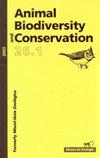The names of southwestern European goats: is Iberian ibex the best common name for Capra pyrenaica?
IF 1
4区 环境科学与生态学
Q3 BIODIVERSITY CONSERVATION
引用次数: 3
Abstract
espanolEl nombre comun asociado a una especie es importante porque sirve de nexo entre los especialistas y las personas no expertas. El uso correcto del nombre comun es importante para la conservacion y gestion de las especies clave o emblematicas. En las publicaciones cientificas en ingles es muy frecuente denominar “Spanish ibex” a Capra pyrenaica y algunos autores defienden la idoneidad de esta opcion,pero en nuestra opinion no es el mejor termino para designar a esta especie. En este articulo proponemos el termino “Iberian wild goat” y revisamos la etimologia, la historia, la taxonomia y el uso del publico en general de los nombres usados para designar a las cabras (domesticas y salvajes) en el sudoeste de Europa durante los dos ultimos milenios. Utilizado por primera vez por Plinio el Viejo, el nombre “ibice” se ha aplicado en la mayor parte de los casos a la cabra salvaje de los Alpes (C. ibex) y son pocos los autores que lo aplicaron a C. pyrenaica hasta el siglo XX, cuando algunas obras influyentes extendieron su uso en las publicaciones cientificas. Los machos adultos de C. pyrenaica tienen cuernos lisos en forma de lira, que no se corresponden con el morfotipo de ibex, que tiene cuernos con nudosidades en forma de cimitarra. Aunque C. pyrenaica y C. ibex probablemente sean dos especies proximas desde el punto de vista filogenetico, sus nombres comunes no necesariamente tienen que coincidir. Los nombres comunes siguen reglas diferentes a las de los nombres cientificos. “Cabra montes” o “cabra brava” (wild goat en ingles) son los nombres comunes utilizados mayoritariamente por los autores de la peninsula iberica. Estos nombres estan profundamente arraigados en las lenguas ibericas y se han utilizado desde las primeras referencias a la especie en la Edad Media. Proponemos que se adopte el termino “Iberian wild goat” en textos juridicos y cientificos y en la interaccion con los medios de comunicacion. EnglishThe common name designated to a species is important because it connects specialists with non–experts. The matter of the correct common name is relevant to the conservation and management of conspicuous or flag species. The English name 'Spanish ibex' to designate Capra pyrenaica is extensive in the scientific literature, and some have defended its appropriateness. However, in our opinion, it is not the best term to designate this species. We propose that 'Iberian wild goat' should be used. Herein, we review the etymology, history, taxonomy and public use of the names used to designate goats (domestic and wild) in southwestern Europe during the last two millennia. Used first by Pliny the Elder, the name 'ibex' has been applied most often for the Alpine wild goat (C. ibex), and few authors applied this name to C. pyrenaica until the 20th century when some influential works extended its use in the scientific literature. Adult males of C. pyrenaica have lyre–shaped, and typically smooth horns that do not match the ibex morphotype, which has scimitar–shaped knotted horns. Although C. pyrenaicaand C. ibex are probably phylogenetically close, their common names do not necessarily have to match. The rules of common names differ from those of scientific names. Cabra montes or cabra brava (wild goat) is the common name used by most authors in the Iberian peninsula. This name is deeply entrenched in the Iberian languages and has been used since the earliest references to the species in mediaeval times. We propose the adoption of 'Iberian wild goat' for legal and scientific communication and when interacting with the media.欧洲西南部山羊的名字:伊比利亚山羊是比利奈加山羊最好的通用名字吗?
与物种相关的通用名称很重要,因为它是专家和非专家之间的联系。该名称的正确使用对关键或象征性物种的保护和管理具有重要意义。在英语的科学出版物中,它经常被称为“西班牙野山羊”,一些作者为这个选择的适宜性辩护,但在我们看来,这不是指定这个物种的最佳术语。在这篇文章中,我们提出了术语“伊比利亚野山羊”,并回顾了过去两千年在欧洲西南部用于指定山羊(家养和野生)的名称的词源、历史、分类学和公众使用。首次使用普利ibice”的男人,名字已经在大多数情况下开始实施野生山羊阿尔卑斯山(c . ibex),只有极少数人对诉pyrenaica直到20世纪,当一些有影响力的延伸工程科学家的出版物。成年雄性C. pyrenaica有光滑的里拉形角,这与野山羊的形态不对应,野山羊的形态有弯刀状的结角。虽然C. pyrenaica和C. ibex在系统发育上可能是两个密切相关的物种,但它们的共同名称不一定相同。普通名称遵循与科学名称不同的规则。“Cabra montes”或“Cabra brava”(野生山羊)是伊比利亚半岛作者常用的名字。这些名字在伊比利亚语中根深蒂固,自中世纪第一次提到该物种以来就一直在使用。我们建议在法律和科学文本以及与媒体的互动中采用“伊比利亚野山羊”一词。这个物种的共同名称很重要,因为它连接了专家和非专家。= =地理= =根据美国人口普查,该地区的总面积为,其中土地和(2.641平方公里)水。The English name‘西班牙ibex to designate Capra pyrenaica is广泛的in The scientific文献,and some have上its的。然而,在我们的观点中,这并不是描述这个物种的最佳术语。我们建议使用“伊比利亚野山羊”。在这里,我们回顾了过去2000年西南欧洲用于指定山羊(国内和野生)的名称的词源、历史、分类学和公共使用情况。过去的first by Pliny the长老,the name‘ibex has been applied most往往for the Alpine wild goat (c . ibex), and politico authors应用this name to c . pyrenaica直到the 20th century when some influential works extended its use in the scientific文学。成人恶of诉pyrenaica have lyre—7,and typically顺利horns match that do not the ibex morphotype, which has been弯刀—7 knotted horns。虽然C. pyrenaica和C. ibex可能在系统发育上很接近,但它们的共同名称并不一定要相对应。= =地理= =根据美国人口普查,该镇的土地面积为。艰苦的山脉或山羊(wild山羊goat) is the common name用来by most authors in the Iberian半岛。= = references = = = =外部链接= = *美国鸟类学会网站*美国鸟类学会网站*美国鸟类学会网站*美国鸟类学会网站*美国鸟类学会网站*美国鸟类学会网站*美国鸟类学会网站我们建议采用“伊比利亚野山羊”进行法律和科学传播以及与媒体互动。
本文章由计算机程序翻译,如有差异,请以英文原文为准。
求助全文
约1分钟内获得全文
求助全文
来源期刊

Animal Biodiversity and Conservation
农林科学-动物学
CiteScore
2.00
自引率
0.00%
发文量
21
审稿时长
>12 weeks
期刊介绍:
Animal Biodiversity and Conservation (antes Miscel·lània Zoològica) es una revista interdisciplinar, publicada desde 1958 por el Museu de Ciències Naturals de Barcelona. Incluye artículos de investigación empírica y teórica en todas las áreas de la zoología (sistemática, taxonomía, morfología, biogeografía, ecología, etología, fisiología y genética) procedentes de todas las regiones del mundo. La revista presta especial interés a los estudios que planteen un problema nuevo o introduzcan un tema nuevo, con hipòtesis y prediccions claras, y a los trabajos que de una manera u otra tengan relevancia en la biología de la conservación. No se publicaran artículos puramente descriptivos, o artículos faunísticos o corológicos en los que se describa la distribución en el espacio o en el tiempo de los organismes zoológicos.
 求助内容:
求助内容: 应助结果提醒方式:
应助结果提醒方式:


